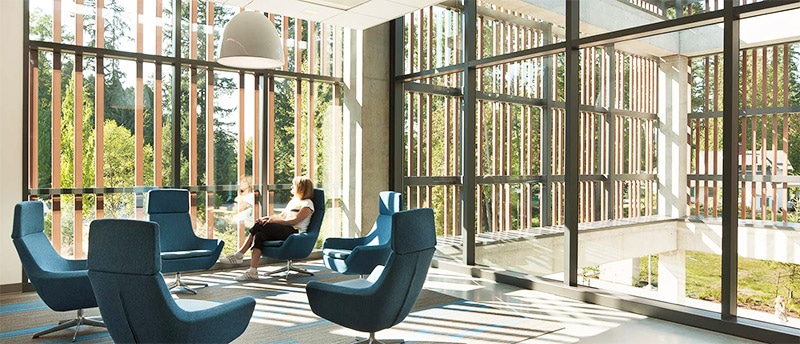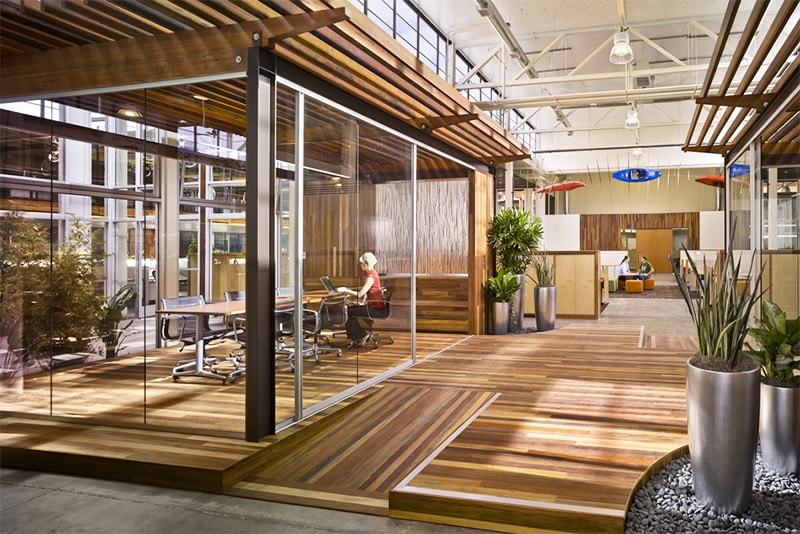The Future Of Biophilic Design In Civil Engineering

As the workforce continues to evolve, so must our approach to workplace design. One such trend gaining in popularity is biophilic design, which involves incorporating nature and natural elements into office spaces to improve employee well-being and overall productivity. In this post, we’ll explore the concept of biophilic design and its potential benefits for the workplace.
What is biophilic design?
Biophilic design is an approach to creating spaces that emphasizes a strong connection to the natural world. The term “biophilia” was first coined by biologist E.O. Wilson in the 1980s and refers to the idea that humans have an innate tendency to seek out connections to other forms of life.
In the context of workplace design, biophilic design involves incorporating natural elements such as plants, green walls, natural lighting, and water features into the office environment. The goal is to create a space that feels more inviting, peaceful, and calming while promoting productivity and reducing stress levels among employees.
Why is biophilic design important?
Research has shown that access to nature and natural elements can have a significant impact on our well-being. For example, a study published in the Journal of Environmental Psychology found that exposure to green spaces can reduce stress levels and improve cognitive function. Other studies have shown that offices with natural light and plants can lead to increased productivity and employee satisfaction.
Moreover, biophilic design aligns with the growing trend towards wellness in the workplace. By promoting a connection to nature and creating an environment that’s more pleasant and relaxing, employers can help improve employee morale and reduce absenteeism.
How can biophilic design be implemented?
There are a variety of ways to incorporate biophilic design into an office space. Here are a few examples:
- Plants and greenery: Adding plants throughout the office, either in pots or through living walls, can create a more natural environment and help purify the air.
- Natural lighting: Maximizing the amount of natural light in the office can reduce the need for artificial lighting and create a more welcoming environment for employees.
- Water features: Installing water features such as fountains or reflecting pools can create a sense of calm and promote relaxation.
- Natural textures and materials: Incorporating natural materials such as wood, stone, and bamboo into the office decor can create a warm, inviting feel and promote a connection to nature.
What are the benefits of biophilic design in the workplace?
There are many potential benefits to incorporating biophilic design into the workplace, including:
- Reduced stress levels: Exposure to natural elements has been shown to reduce stress and anxiety levels among employees.
- Improved cognitive function: Access to natural light and a more calming environment can improve focus and concentration.
- Increased productivity: Studies have shown that incorporating natural elements into the workplace can lead to increased productivity.
- Better employee health: Access to green spaces and natural light has been linked to improved physical health outcomes such as reduced blood pressure and a lower risk of obesity.
- Enhanced creativity: A more relaxed and positive environment can promote creativity and innovation among employees.
What are the potential drawbacks of biophilic design?
While the benefits of biophilic design are clear, there are a few potential drawbacks to consider as well:
- Cost: Incorporating natural elements into the workplace can be costly, especially for smaller businesses.
- Maintenance: Living plants and green walls require ongoing care and maintenance, which can be time-consuming and expensive.
- Allergies: Some employees may have allergies or sensitivities to certain plants or natural elements, which can impact their ability to work effectively in a biophilic space.
Conclusion
As we continue to evolve our approach to workplace design, it’s clear that biophilic design will play an increasingly important role. By incorporating natural elements into the office environment, employers can create a more relaxing, inviting, and productive space that promotes employee well-being and supports the overall goals of the organization.
While there are some potential downsides to biophilic design, the benefits are clear. Whether by incorporating plants, natural light, or water features into the office space, employers can help create a more positive and wellness-focused environment that benefits both employees and the organization as a whole.


Post a Comment for "The Future Of Biophilic Design In Civil Engineering"